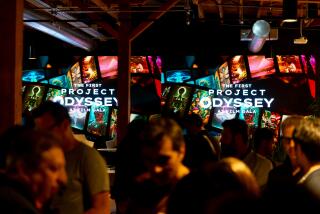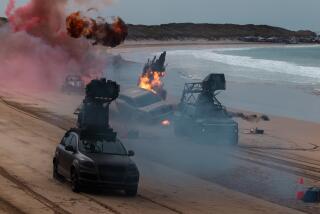No groupies, but he’s got an Oscar
- Share via
An Oscar means many new friends. The morning after receiving a statuette at this year’s Scientific and Technical Awards presentation Feb. 14, Bill Tondreau discovered this firsthand. As he walked through a busy hotel lobby, nearly everyone stopped to notice the little golden guy in his hand. Many people wanted a closer look, while the truly brave even asked to hold it.
When Tondreau responded to the inevitable question of how he earned the award, reactions ranged from polite acknowledgment to dumbfounded confusion. Tondreau, 58, had been honored for his work in developing the motion-control technology that he estimates is now used in 90% of the Hollywood films that feature special effects.
A California native, Tondreau began his career working in the office of legendary designer, architect and filmmaker Charles Eames. It was there that he began experimenting with motion-control systems, and his work has gone on to be featured in films ranging from “Tron” to the “Lord of the Rings” trilogy.
It’s difficult to explain to people what you do in concise terms, isn’t it?
When I went down the press line last night, boy, I tried hard. I found myself punting, falling back on buzzwords or mentioning particular films. It is hard because there’s no precedent. You can’t say, ‘Well, it’s like this situation that you know.’
So how would you explain it?
Motion control involves two things. One is a mechanical device that usually resembles a traditional, hand-operated camera dolly with a boom arm, but all the camera positioning is controlled by motors rather than human hands. The motions of these motors are coordinated by computer software, the second thing. It guides the camera through the motion choreography -- and can do it again and again exactly the same way.
The ability to repeat a sequence of motions exactly sounds important. Is it?
It opens up a lot of possibilities. There’s a wonderful scene in the first “Lord of the Rings” film where Frodo walks out onto a porch. The camera pulls back to reveal a vista of the Elvin village Rivendell and some distant waterfalls. This scene was built up from three separate image sources. First there was a live-action shot of Frodo on a porch set, shot by a large motion-control boom camera doing a pull-back. Then that same pull-back was reproduced by another motion-control rig that photographed a miniature village. Finally, the same pull-back was applied to a computer graphic scene of distant waterfalls. Then selected pieces of all three shots were combined to produce the final scene. Since the camera motion on all the shots was identical, they fit together perfectly -- and the scene looked real.
Scenes like that have been done for decades, but they always had to be static, with a motionless camera.
Does it nag at the sci-tech community that you aren’t a part of the main Academy Awards ceremony? If you’ve ever been to the big ceremony, it’s an ordeal. You’ve got to get there early, and you’ve got to sit there with very little chance of going to the bathroom or any creature comforts through this very long ceremony. But our ceremony is like the original Academy Awards ceremonies, in that it’s a dinner party, sitting around a table with friends and colleagues. And this way I got to give a much longer speech.
How did you get started working on motion control systems?
I’m not sure I started doing this because of “Star Wars,” but the earliest, crummiest, crudest personal computers were starting to come out at that same time. And I saw that if I learned this technology it was going to be a pretty powerful thing for me to possess. So I really got into it. I’m never good with ideas in the abstract, so under the influence of “Star Wars”’ motion control I picked up the learning of computer technology in the context of how I could use it for theatrical motion control. So I built all these primitive systems in my little $120-a-month apartment in Venice.
Did you have any training in electrical engineering?
No, I was an English major. I just learned it all with trips to Radio Shack and back issues of Popular Electronics at the Santa Monica library. When I realized I needed to do something I didn’t understand I’d muck around at the library until I found a way to do it.
Do only the big studios use your technology?
My equipment is hooked up to hundreds of different camera systems. Some of them are manufactured by big companies who’ve been in the business a long time, but the majority of them are manufactured by the individual operators actually using them. Some people do great things with junk, and some people go very high tech. My sympathies tend to be with the junkers.
More to Read
Only good movies
Get the Indie Focus newsletter, Mark Olsen's weekly guide to the world of cinema.
You may occasionally receive promotional content from the Los Angeles Times.









